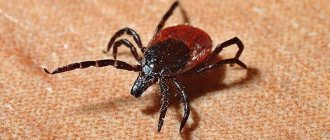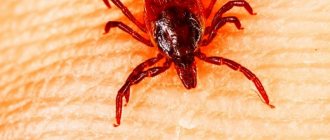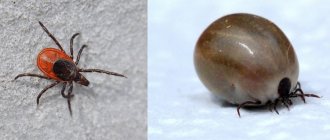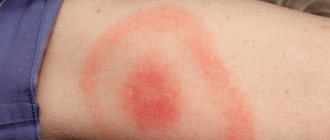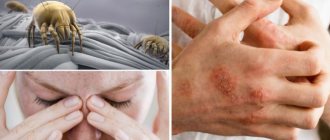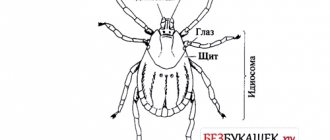In spring and summer, as soon as the sun begins to warm up, everyone rushes to nature - to the forest, to dachas, to parks, etc. At the same time, we often do not fully understand what danger forest ticks pose to humans, and to domestic animals too. In fact, a small and inconspicuous forest tick often becomes a carrier of serious diseases, the number of which reaches 60!
In this article, let's get acquainted with these little vampires, their varieties, find out why they are so dangerous, how to deal with forest ticks and how to act correctly when bitten.
A forest tick bite can cause about 60 diseases
What does a forest tick look like?
Forest tick
is an arachnid insect with an oval-shaped body, on the upper side of which there is a shield. In male ticks, the shield covers the entire upper side of the body, and the body of the insect itself has a hard skeleton. In females and nymphs of ticks, as well as ticks in the larval stage, the shield covers only the front part of the upper side, other parts of the oval body are soft, this allows the ticks to increase in size when stretched during blood sucking. Males of the European forest tick are brown in color and about 2.5 millimeters long. Female ticks are larger than males; the length of a female tick in a hungry state is 4 millimeters; after saturation with blood, the body of a female tick increases in size to 11 millimeters and becomes gray in color. Ticks have 4 pairs of legs, four on the right and left sides of the body. The forest tick differs from the taiga tick in the marginal furrow of the body; the forest tick does not have this body outline in the lower part, but the taiga tick has such an outline along the entire edge of the body.
the image is the property of the Finnish University of Turku
Appearance of the parasite
Dog, taiga and other ixodid ticks look similar to each other in appearance (see pictures below). Sometimes even specialists cannot quickly distinguish them without additional thorough research.
The color and size of these parasites can vary widely: from flesh-colored to dark gray or brown. Folds on the integument can sometimes form bizarre patterns, and the soft chitin of larvae and nymphs is translucent - the color of blood in the tick’s digestive system is visible through it.
Thus, when trying to determine the type of attached parasite, there is no point in relying only on color.
All ixodids also have a similar type of body structure. It consists of the head section (gnatosomes) and the body (idiosomes) - the structural features can be seen in more detail in the photograph below:
The idiosome has the appearance of a highly extensible sac, thanks to which the parasite can absorb blood in volumes significantly exceeding the body size of a hungry individual.
On the ventral side of the idiosoma there are four pairs of walking legs (tick larvae have only 3 pairs of legs, so sometimes people confuse them with insects).
In adult individuals, sexual dimorphism is well expressed: males are very different from females. Firstly, males are much smaller than females; the dorsal part of their body is covered with a dense shiny shield that reaches the top of the abdomen. Because of this, the body of males does not stretch as much as that of females, in which the scute reaches only half of the back.
Females are usually larger than males and feed on the host longer (sometimes adult males do not drink blood at all, and quickly die after mating). The success of the formation of mature eggs and the continuation of the parasite species depend on blood saturation. If for some reason the female did not find a host or fell away without being fully nourished, then the reproductive products will not form inside her, and she will not be able to lay eggs.
Hyalomma anatolicum (left - female, right - male)
On the head section of the tick's body there are simple eyes that perceive changes in light intensity. The main sensitive function is performed by the chemical sense organs located on the paws: it is by smell that the tick finds its victim. Bloodsuckers also react intensely to heat (infrared radiation), which is scattered from warm-blooded animals.
Of particular interest is the structure of the tick's oral apparatus, which can only be examined in detail under a microscope. The parasite's oral apparatus consists of:
- hypostome (proboscis with a rim of hooks);
- pairs of chelicerae;
- pairs of pedipalps.
The pedipalps contain the sensory organs discussed earlier. Chelicerae look like sharp knives that cut the integument of the victim. The proboscis looks like an elongated harpoon cylinder: when bitten, the parasite completely immerses it in the wound, feeding on blood, lymph and inflammation products.
On a note
The tick is very firmly fixed in the wound thanks to a rim of hooks located in longitudinal rows along the entire proboscis. They differ in size and angle of inclination. After inserting the oral apparatus, the hooks become tightly fixed in the skin and tissues, especially if you try to forcefully pull out the parasite. Often such a procedure ends for the victim with the proboscis remaining in the wound.
Forest tick activity season
The active season of forest ticks begins in early spring; individual insects appear before the snow finally melts. In the North-West region, the first visits to medical institutions after forest tick bites were officially registered in early March. The peak population of forest ticks occurs at the end of May - beginning of June. From July the number of insects decreases, in August - September the number of ticks increases again, as the second wave of parasite invasion begins and their numbers increase everywhere.
What to do if you are bitten?
What to do if you are bitten by a forest tick? Many people get scared and start doing things that aren’t quite right, dousing the tick with vegetable oil and vodka. It is important to provide first aid correctly, as human health depends on it.
First aid
First aid should be provided by doctors, so it is advisable to go to a special institution so that they can get the forest tick and properly treat the affected area. But if this is not possible, then you should remove the parasite yourself. To do this, you will need forceps, alcohol or chlorhexidine, soap and water.
In almost every pharmacy you can buy a kit that includes tools for extracting forest ticks. You can buy it and take it with you when you go outdoors.
The process itself consists of several stages:
- First, treat your tools with alcohol. The place where the tick sits should also be treated. If possible, wash your hands with soap to avoid introducing another infection through the wound.
- Take tweezers and fix it as close as possible to the head of the parasite. This is very important, because when pulling out a tick, you need to remove it entirely. If the body is torn away from the head, then it will be impossible to get it out on your own. Moreover, as long as part of the tick is under the skin, it continues to poison the human body.
- Having captured the parasite, begin to slowly scroll it counterclockwise. At the same time, you need to pull it slowly and under no circumstances pull it out with all your might.
- Once you have taken out the tick, place it in a container and take it to the laboratory. There they will conduct research and tell you whether the tick was sick and whether the person became infected.
- Wash the wound thoroughly with soap, lubricate it with an antiseptic and bandage it.
Mark the day of the bite on your calendar to monitor whether any symptoms develop and, if so, how quickly.
Once a tick is discovered, action must be taken immediately. No pills, syrups or traditional methods will help. To minimize the possibility of infection, you need to remove the entire parasite as quickly as possible.
Do I need to go to the hospital?
Do I need to go to the hospital after a tick bite? Of course yes! Even if you pulled it out yourself, the doctor should examine the bite site and check whether everything was removed. Moreover, the health station records every forest tick bite, and the victims are under observation for some time (even if the tick was not a carrier of the disease).
A week after the bite, the person who was attacked by the tick must have his blood tested. This should not be neglected even if there are no symptoms, since, for example, Lyme disease develops slowly.
It is necessary to go to the hospital as an emergency if a tick has bitten a person with allergies, immunodeficiency, as well as a child or pregnant woman. Here the clock counts. You should not try to do something yourself, as this can lead to undesirable consequences.
Forest tick habitat
Ticks live in vegetation close to the surface of the earth, the main habitat of ticks is the forest floor of compacted leaves, fallen needles, grass and moss; the opinion that ticks live in tree branches is erroneous. In humans, ticks appear first on the legs, after which they crawl up them; for this reason, insects are most often found on the legs, knees and thighs.
Where do ticks hide in summer?
The places where ticks hide in summer are the same where they are in spring and autumn throughout their activity. Insects accumulate:
- In grass
- Any dense vegetation
- Plant leaves
- Humus on the ground
- Compost heaps
- Cracks in foundations at ground level
- Cavities behind tree bark
- Under the fallen leaves
- Stacked building materials and garbage
Any secluded, damp place at a height from the ground to 1 meter up is suitable for ticks.
How a tick bites
After falling on a person, the tick crawls along it from bottom to top in search of thin areas of skin. Common sites for tick bites in adults are the legs, buttocks and genital areas. Ticks most often bite children on the head; according to statistics, it accounts for 75% of insect bites. It may take several hours from the moment it gets on your clothing until it bites. For this reason, after visiting forested areas or untreated city parks, it is necessary to carefully inspect all clothing, both from the outside, in search of insects crawling on it, and from the inside, to make sure that there are no parasites crawling under the clothes. Over the previous year, 175,000 cases of tick bite victims visiting medical institutions were registered in Russia, of which 47,000 were children (26.8%).
Looking for a victim
Ticks do not fall from trees, as many people believe. They crawl slowly from bottom to top. They sit on the grass or on a bush and feel the approach of a “victim” – a person or an animal – one and a half meters away.
– Ticks cling to clothing and begin to climb towards thin skin. Slowly but surely they find the right place on the body. They won’t dig into the heel, the ticks’ favorite places are the groin, armpits, neck, delicate skin behind the ears, on the head, clarifies Elena Babura. – From the moment the small arthropod makes its way, on average, an hour and a half passes. This is exactly the time during which it can be detected. The tick bites in painlessly - the saliva contains an analgesic and “cement”, and on the oral cavity there are hooks located against the movement, which makes it difficult to pull it out. In the first second of the bite, the virus from the tick’s saliva infects the blood.
Danger of forest ticks for humans
The forest tick is a keeper and carrier of infections that pose a mortal danger to humans. One insect can contain several types of viruses - tick-borne encephalitis, tick-borne borreliosis, tick-borne rickettsiosis, ehrlichiosis, babesiosis, anaplasmosis. Pathogens enter the human blood through the tick's saliva, which the tick releases to relieve pain when bitten. The incubation period ranges from two to fourteen days; as a rule, this is a fairly acute infection, accompanied by chills, fever, and elevated temperature. The victim's face becomes redder as a result of hyperemia; in some cases, hyperemia spreads to the entire body of the person bitten by a tick. No one is safe from a tick bite. Ticks are not selective; they bite all warm-blooded animals, without distinction based on gender or age restrictions. The number of fatal cases among people infected with tick-borne encephalitis ranges from 2% to 6%; annually in Russia from 25 to 50 cases of tick-borne encephalitis with a fatal outcome are recorded. The risk of contracting tick-borne encephalitis is negligible; only 2–3% of ticks are carriers of the disease. However, the optimal solution in a situation where a tick has bitten is to remove the insect and submit it to the laboratory for analysis, so that a professional infectious disease specialist can check the parasite for infection in its body.
Why are there more and more ticks?
It turns out it's not the mites at all. They themselves are quite harmless. They were slandered. Ticks are carriers of infection; they are victims, not criminals. They are infected by small forest animals. If our country is completely enslaved by ticks, the number of cases may not increase, but even decrease. But if mice or hedgehogs are enslaved, epidemics are inevitable. In recent years, there has been an increase not in ticks, but... in mice. There are many reasons for this. For example, the amount of household waste in parks and forested areas attracts small rodents. Climate change - the warmer the winter, the higher the likelihood that both ticks and small animals will survive the winter well. Logically, after the frosts that tormented us this winter, there should be less of both. But if you ask a doctor from a vaccination center or an insurer, or a representative of a pharmaceutical company about the “tick-borne” situation, they will, of course, answer you with horror in their eyes: there are more and more ticks every year, MORE!
Precautions against ticks
To protect yourself from ticks and avoid their bites, you need to take precautions when visiting natural sites, forests, city parks and other recreational areas. First of all, it is necessary to understand that ticks pose an absolutely real threat to life and health, thereby realizing that precautionary measures in tick habitats are mandatory, not desirable.
I
When visiting areas where ticks are likely to be present, for example, a mixed forest of deciduous trees, you need to dress in such a way that your clothing does not allow ticks to crawl under it - trousers tucked into boots or socks, a long-sleeved shirt tucked into trousers, tightly fitting to the body of the collar of the shirt and sleeve cuffs, a mandatory headdress. Preference should be given to light-colored clothing, on which insects can be easily spotted
II
The optimal solution before going to the forest would be to treat outer clothing with a solution of an acaricidal agent against ticks; if ticks get on treated clothing, after a short time they will lose their tenacity and the ability to crawl on it, fall off and die. The solution requires a cypermethrin-based product, for example, Tsifox anti-tick product
III
When camping in nature with an overnight stay, you must choose places devoid of grass, for example, dry areas in a pine forest or areas with sandy soil. Before and after spending the night outdoors, you need to carefully inspect your clothes, body and hair to make sure there are no insects
IV
After visiting natural places with pets, you need to carefully examine your pets to make sure they are free of ticks.
V
To sit in the forest, you should choose a stump or a stone; you should not sit or lie on the grass
Which ticks are the most dangerous in the forest?
It is dog and taiga ticks that more often than all others parasitize humans and, most importantly, carry a number of dangerous diseases. Therefore, these mites are given priority attention.
These parasites are found in all types of forests in our country, but their species diversity and abundance vary depending on the natural zone. For example, Ixodes ricinus is confined to well-lit broad-leaved and coniferous-deciduous forests, where it prefers moist, sun-warmed areas. This species is distributed south to the semi-desert zone.
Ixodes ricinus
Ixodes persulcatus, on the contrary, is confined to coniferous forests, and is much less common in mixed forests. In the steppe zone, the taiga encephalitis tick is completely absent.
The photo below shows an adult female taiga tick Ixodes persulcatus:
This is what the male looks like:
On a note
Representatives of the genus Dermaceptor, also feeding on blood, are distributed throughout Asia and Europe, reaching the shores of the Pacific Ocean. In the north, the habitat reaches the taiga zone. Dermaceptor spp. found in deciduous and mixed forests of various types. Preferred habitats are meadows with tall, lush vegetation. They do not live in open steppe areas.
Dermacentor reticulatus
So it is quite difficult to determine in advance which forest will have the most ticks. Be that as it may, when in nature, you should know the places where parasites are likely to concentrate.
There is a nuance here: with regard to ticks, as among insects, the so-called “law of station change” operates - as the range moves southward, the species’ need for moisture increases. Therefore, if in the taiga the taiga tick will look for dry, well-warmed areas, then in the zone of mixed and deciduous forests the accumulation of parasites will be observed in shaded, damp and fairly cool places. This should be taken into account when choosing vacation spots in the forest.
Bitten by a tick what to do
Once a bitten tick is found on the body, it must be carefully removed. Removal of a tick is carried out using tweezers; you need to carefully grab the tick as close as possible to the site of the bite on the skin, strictly perpendicular to the surface of the skin, and without sudden movements, slowly rotate the insect around its axis clockwise and counterclockwise, carefully ensuring that do not tear the insect's head from its body and leave it in the skin. After removing the insect, it is necessary to thoroughly disinfect the bite site with any available means suitable for these purposes - cologne, iodine or undiluted alcohol.
Facts about ticks
Ticks can survive underwater for 3 weeks. Therefore, do not flush the tick in the toilet. He will most likely survive this. And who knows, maybe he will crawl out to take revenge.
Ticks do not like heat, but need warmth and high humidity - they prefer places where air humidity is above 85%. Therefore, they are especially active after rain.
The tick can survive in the house for several days. Arachnids can be removed from clothing using adhesive tape.
Vaccination does not protect against ticks! A vaccinated person remains defenseless against all infections except tick-borne encephalitis.
– When you go on a picnic, take a white sheet with you. Our specialists check green areas for the presence of ticks with a white flag - they simply run a white cloth over the grass and look at the “harvest”. We don’t find any species! If you have chosen a place to rest, run a white sheet over the grass and see if it is worth staying there or if it is better to look for another clearing. You need to look for another place even if only one tick is attached to the sheet, says epidemiologist Elena Babura .
Of course, not all ticks are infected with the encephalitis virus or borreliosis (Lyme disease), but this does not allow you to relax.
If the tick's head remains in the body
If a tick is decapitated during its removal, this will be visible as a black dot at the site of the bite; swelling, slight swelling, and possible discharge of pus may appear on the damaged area of the skin. The bite site must be treated with chlorhexidine for external use several times a day. In rare cases, if the head of the tick remains in the body, there may be a pronounced inflammatory reaction at the site of the bite, characterized by large swelling, increased temperature and copious discharge of pus. The tick's head remaining in the body does not affect the likelihood of illness, since infection occurs at the time of the bite due to bacteria in the parasite's saliva. If the head of the tick remains in the body, and a skin abscess (a pus-filled lump the size of a large pea) appears at the site of the bite, the boil can be pierced with a disinfected needle, the head of the tick should come out of the body along with the pus. The site of the abscess must be disinfected with antibacterial cream or special ointment, sold at any pharmacy.
When and how to administer immunoglobulin
An injection of gammaglobulin (immunoglobulin) is administered within three days from the moment of the bite. There is no point in placing it on the fourth day or later. If you are vaccinated, but you are bitten by several ticks at once, an injection is also given. Immunoglobulin does not provide a 100% guarantee against infection, but it softens the course of the disease. The cost is paid by the patient himself (about 700 rubles), children under 16 years old and pensioners are free. Course: three injections. It is important to know that the administration of immunoglobulin is an emergency measure and has its side effects. It can lead to a weakening of the immune system in the future, as there is a powerful rise and then a decline. After the injection, you need to monitor your condition. Pregnant and breastfeeding mothers should discuss the issue of administering immunoglobulin with a doctor, since this drug has not been tested in this population, and the risk must be justified. There is stupid advice about giving an injection as a preventative measure before resting - the condition may worsen. And you don’t need to bring immunoglobulin with you either. Although some people use a special container for storing ampoules with a cold element (for example, if they live in the country for a long time) or simply store them in the refrigerator door.
From the rusmedserver memo (rusmedserv.com):
We DO NOT RECOMMEND the use of immunoglobulin for emergency prophylaxis in camping conditions. This is a protein drug that can cause a severe allergic reaction (even fatal), which is impossible to cope with in the field without special training and medications. In addition, immunoglobulin requires strict adherence to storage conditions (+2 - +8ºС), which is very difficult to comply with in field conditions.
When will it be possible to go out onto the site after treatment?
After about 2-3 hours. In fact, normal life activities can be carried out on the site once the chemical has dried on the sprayed grass and soil. Since the treatment is carried out only in dry weather, the specified 2-3 hours are required for such drying.
If the treatment is carried out in the morning, then after lunch you can already walk on the site
You can simply walk along the paths on the site almost immediately after finishing the work. It is important at this time not to go onto the lawn, grass, or garden, so as not to shake off drops of acaricide from the plants onto the ground.
Do all ticks die, or do some of them remain alive?
Let's put it this way: in 92% of the areas that we process, not a single tick is found on people, animals, or grass until next year. In 6% of areas treated in the spring, single ticks were found in the fall, and in 2% in the summer.
If the treatment is carried out annually, in the spring, then after two years of such systematic protection, ticks are not seen in the areas at all.
We believe that after high-quality treatment there are no live ticks left on the site at all. Those that appear here over time penetrate here on their own, or are brought in by wild animals (mice, hedgehogs, lizards), or by the wind. But it is impossible to prove this with any research. You won’t inspect every blade of grass and pebble on 10-20 acres of a garden or vegetable garden. Yes, it is not necessary - if ticks do not bother people, then this is exactly the result that is required from the treatment.
Hedgehogs are one of the most active spreaders of ticks
In a separate article, we examined in detail the effectiveness of treating an area against ticks...
Protection in all directions
Epidemiologists claim that many of those bitten were not injured in the forest, but in local areas and summer cottages. Ticks can come directly into your home on animals - dogs and cats; they can be brought by guests on clothes or with wildflowers and branches.
– Anti-tick sprays or lotions are a good way to protect yourself. The main thing is to read the instructions, advises Ekaterina Morozova. – In addition to age restrictions, it indicates the time during which the product is effective, and the range is large – from 30 minutes to several hours. Even when using these products, check your clothes and skin every hour and a half. First of all, look carefully at the folds of the skin: ticks love warm and moist places.
Remember that it is easier to see the insect on light-colored clothing.
Is it possible to treat the clearing where we want to have a picnic with something?
Theoretically, this can be done with the same means used to treat the area. But in reality, effectively spraying a clearing will take longer than the picnic itself, and will take so much effort that you will no longer be able to enjoy being in nature here. It is wiser to dress for a picnic in such a way that a tick that accidentally gets on your clothes is visible and can be removed immediately. Or use repellents applied to the skin to prevent the tick from even getting on you. This will be enough to relax calmly and safely.
Tick-borne typhus
Tick-borne typhus is one of several similar diseases caused by Rickettsia bacteria. The name comes from the Greek "typhos", meaning "smoky", or "foggy", which describes the state of mind of those affected by typhus. The pathogen is an obligate intracellular bacterium that cannot survive for long periods outside of living cells. Typhoid is transmitted to humans through external parasites such as lice, fleas and ticks.
Signs and symptoms begin with sudden fever, chills, headache and other flu-like symptoms, 1 to 3 weeks after infection.
Five to nine days after symptoms first appear, a rash begins to develop, usually starting on the torso and spreading to the extremities. This rash will eventually spread throughout the body, sparing the face, palms and soles.
Signs of meningoencephalitis begin simultaneously with the rash and actively develop over 2-3 weeks. Other signs of meningoencephalitis include sensitivity to light, changes in mental status (delirium), and coma. Without treatment, death can occur in 10 to 60 percent of patients, with patients over 60 years of age at greatest risk.
